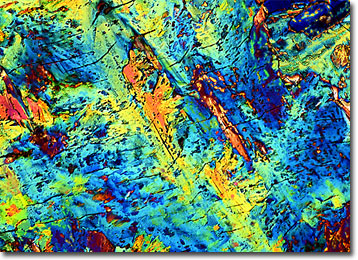Polarized Light Microscopy Digital Image Gallery
Mannose
Mannose is a relatively uncommon natural simple sugar that is a stereoisomer of glucose. The saccharide is utilized for a variety of purposes, including commercial fermentation, the production of artificial sweeteners, and as an ingredient of fertilizers.

Mannose occurs in two different isomers known as mannopyranose and mannofuranose, which contain 6 carbon, 12 hydrogen, and 6 oxygen atoms per molecule and feature a melting point of 132 degrees Celsius. In nature, the saccharide is found in glycolipids and glycoproteins of certain plants, fungi, and bacteria in polymerized forms known as mannans, which act as food energy supplies. The enzyme hexokinase may phosphorylate mannans to form mannose-6-phosphate, a substance that isomerizes to fructose-6-phosphate before entering into the glycolysis or gluconeogenesis metabolic pathways.
Since mannose is natural, the United States Food and Drug Administration classifies the saccharide as a nutritional supplement rather than a drug. Yet, it is sometimes prescribed by doctors as a form of medical treatment. For instance, mannose, which is also marketed under the names seminose and carubinose, is often recommended for those suffering from urinary tract infections caused by Escherichia coli, a common gut bacteria. The reason mannose is an effective treatment for such infections is that the sugar coats the bacterial cells and makes them less inclined to stick to the lining of the urinary tract so that they may be readily flushed away with urine. Moreover, since mannose is absorbed in the upper gastrointestinal tract, the beneficial E. coli of the lower intestines are not affected.
